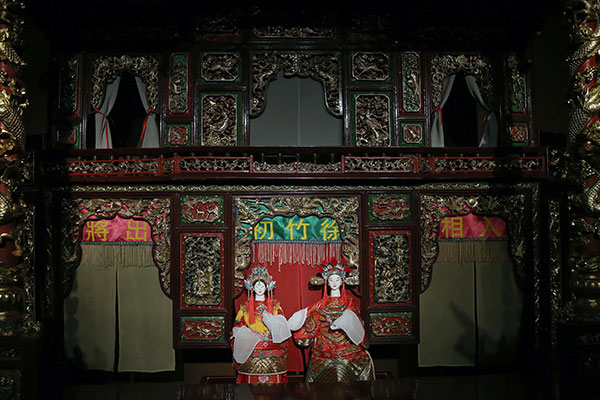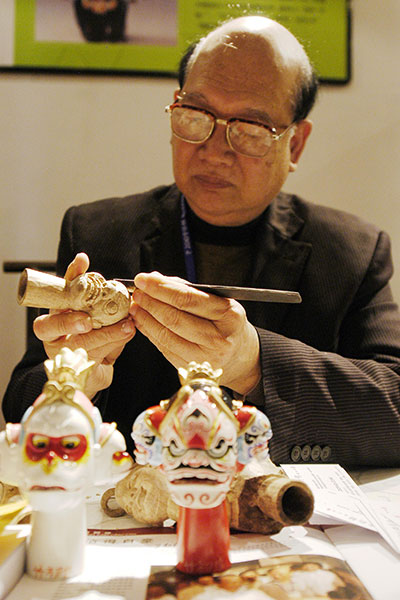
The figurines of Peking Opera by puppetry master Xu Zhuchu are among exhibits of an ongoing display at the National Art Museum of China. [Photo by Jiang Dong/China Daily]
A master carver brings his family craft to the sixth generation, investing his wooden creations with eyes and other facial features that move. Lin Qi reports.
The name of Xu Zhuchu means “newly grown bamboo”, embracing a wish for extraordinary vitality that would keep the family thriving for generations.
Now 78, Xu, a State-level inheritor of the puppet-carving technique, is still creative and hard at work at his home and studio in Zhangzhou, Fujian province.
In a career spanning six decades, Xu has used camphor wood to create some 600 characters from different walks of life and in both the human and fairy world. He has also carried forward six generations of puppet-making, a family business that could be traced back to the first handicraft studio opened by his ancestors during the reign of the Qing Dynasty Emperor Jiaqing (1796-1820).
Last month Xu donated nearly 400 puppets, mostly his works and some from the earlier generations of the family, to the National Art Museum of China. They are now on show at the museum through February.

Puppetry master Xu Zhuchu. [Photo by Zhang Bin/ China Daily]
Xu’s family craft mainly caters to the time-honored Zhangzhou glove puppet show. The performance used to entertain locals in eastern China for centuries and today amuses both home and overseas audiences.
A skillful performer manipulates his puppet by putting one hand into its body, which is made into a glove; his index finger operates its head, whose vivid movements and facial expressions rely on the handicraft of the Xu family.
Xu was born with a deep affection for puppet-making. He loved watching his father, Xu Niansong, carve out lively figurines. His parents, however, didn’t want him to continue the family business. They sent him to school in the hope that he would land a stable job after graduation.
“We took shelter in a shabby house, and we had no farm lands to live on. Making puppets would barely support the whole family,” Xu recalls.
But in his free time after school, Xu’s crafting skills improved. He was so focused on the work that he once got his hair burned by an oil lamp. His fingers were often hurt by the slippery knives: There was blood all over the molds.
At 16, his three puppet works won the top prize at a national youth handicraft expo. Because of his talent in the craft, Xu was recommended for admission to the Central Academy of Fine Arts. But at the time, his mother’s sudden death made him drop his plans for further studies in Beijing. Being the eldest child, he decided to stay at home to take care of the family.
Xu entered a local puppet-show troupe. He has since turned into a dynamic, imaginative band of puppets.

A Buddhist image by puppetry master Xu Zhuchu are among exhibits of an ongoing display at the National Art Museum of China. [Photo by Jiang Dong/China Daily]
The puppets born under Xu’s carving knives seem to “show” emotions of people and their spiritual pursuits. He finds inspiration from real-life experiences, but he also frequents storytelling performances, and observes Buddha statues inside temples, and he enjoys the Peking Opera and the Yueju Opera of Zhejiang province.
He sculpts the same smooth lines and graceful expressions as that of Buddhist images. He paints on the puppets with a palette as rich and bold as that of the facial make-up in traditional operas and nianhua (New Year paintings).
Above all, he injects infinite imagination and romantic feelings into them. He creates various features to reveal a greedy character: a pair of slanted eyebrows, buck teeth, dilated eyeballs and a bushy mustache, to name a few.
Among the hundreds of puppets he creates, one can hardly find two looking alike.
When Xu started making puppets, there were about 200 characters mostly derived from traditional opera scenarios. He has expanded the group to the current 500 to 600 characters from operas, folk and fairy tales and literary classics.
“The special aspect of Xu’s puppets is that their eyes, eyebrows, mouths and lips can move-he has breathed life into them,” says Wu Weishan, director of the National Art Museum of China.
“When he holds a puppet, he talks to it. When he presents the puppet to the audience, it can talk to the people.”
Under his discipline, Xu’s son and several young apprentices are carrying forward the handicraft. But Xu knows that few young people can “endure the loneliness of becoming a master” and these days it is the market recognition that makes them stay with puppetry.
He says puppet artists in the past barely supported themselves because they could find only two customers-puppet troupes and children.
“The troupes would use a set of puppets for dozens of years, while parents bought their children puppets mostly during festivals.”
Now the times have changed, he says.
“We mass produce tourist souvenirs that are cheaply priced and we also make high-end artistic works. That’s how I can pass down the art of puppetry to future generations.”
If you go
9 am-5 pm, through Feb 28 (Mondays closed). National Art Museum of China, 1 Wusi Dajie, Dongcheng district, Beijing. 010-6400-1476.
